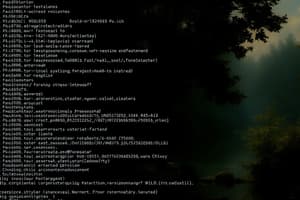Podcast
Questions and Answers
What command would you use to display the current time in a 12-hour format?
What command would you use to display the current time in a 12-hour format?
- date +%r (correct)
- date +%H:%M:%S
- show time
- time now
Which command would help you determine the file type of '/home/student/zcat'?
Which command would help you determine the file type of '/home/student/zcat'?
- file /home/student/zcat (correct)
- ls -l /home/student/zcat
- cat /home/student/zcat
- type /home/student/zcat
What is the purpose of pressing the Tab key twice in the Bash shell?
What is the purpose of pressing the Tab key twice in the Bash shell?
- To show a list of matching file names (correct)
- To display available command options
- To exit the command line
- To enter the previous command
How can you quickly repeat the previous command using the command line shortcuts?
How can you quickly repeat the previous command using the command line shortcuts?
Which command would you use to list the last 20 lines of the zcat file?
Which command would you use to list the last 20 lines of the zcat file?
What is the primary function of the Bash shell?
What is the primary function of the Bash shell?
Which keyboard shortcut moves the cursor to the end of the line in the command line interface?
Which keyboard shortcut moves the cursor to the end of the line in the command line interface?
What does the command 'file myfile' do?
What does the command 'file myfile' do?
How can you access the built-in help options for a command in Linux?
How can you access the built-in help options for a command in Linux?
Which of the following commands shows the last 5 lines of a file named myfile.txt?
Which of the following commands shows the last 5 lines of a file named myfile.txt?
What is the purpose of the Ctrl+R shortcut in command-line editing?
What is the purpose of the Ctrl+R shortcut in command-line editing?
What feature does the Activities button provide in a Linux desktop environment?
What feature does the Activities button provide in a Linux desktop environment?
What does tab completion do in the command line?
What does tab completion do in the command line?
What command would you use to display the current date and time in the format of hours and minutes?
What command would you use to display the current date and time in the format of hours and minutes?
What key combination can you use to switch between different workspaces in GNOME?
What key combination can you use to switch between different workspaces in GNOME?
Which command would you use to identify the type of a file?
Which command would you use to identify the type of a file?
How can you complete a partially typed command or filename in the terminal?
How can you complete a partially typed command or filename in the terminal?
To list previously executed commands in the shell, which command should you use?
To list previously executed commands in the shell, which command should you use?
What is the purpose of the 'passwd' command in Linux?
What is the purpose of the 'passwd' command in Linux?
Which command can be used to view the first three lines of a file?
Which command can be used to view the first three lines of a file?
What is the effect of using '' at the end of a command line in the terminal?
What is the effect of using '' at the end of a command line in the terminal?
Flashcards
Bash shell commands
Bash shell commands
Commands used to interact with the operating system, performing tasks like executing programs, managing files, and displaying information.
date command
date command
A command that displays the current system date and time.
wc command
wc command
A command that displays the line count, word count, and byte count of a file.
Bash shortcuts
Bash shortcuts
Signup and view all the flashcards
File type identification
File type identification
Signup and view all the flashcards
GNOME Help
GNOME Help
Signup and view all the flashcards
Activities Overview
Activities Overview
Signup and view all the flashcards
Command Options
Command Options
Signup and view all the flashcards
Tab Completion
Tab Completion
Signup and view all the flashcards
Workspaces
Workspaces
Signup and view all the flashcards
date command
date command
Signup and view all the flashcards
passwd command
passwd command
Signup and view all the flashcards
History Command
History Command
Signup and view all the flashcards
Bash Shell
Bash Shell
Signup and view all the flashcards
Command-line Editing
Command-line Editing
Signup and view all the flashcards
Workspaces
Workspaces
Signup and view all the flashcards
Activities Button
Activities Button
Signup and view all the flashcards
file command
file command
Signup and view all the flashcards
head command
head command
Signup and view all the flashcards
tail command
tail command
Signup and view all the flashcards
Tab Completion
Tab Completion
Signup and view all the flashcards
Study Notes
Chapter 2: Accessing the Command Line
- Topic: Introduction to the Bash Shell
- Presenter: Hasnaa Sleiman
- Course: Master in telecommunications, Networks and Security
- Institution: UA-USJ-UL
Objectives
- Understand how to log in to a Linux system
- Learn how to run commands using Bash shell
- Explore the structure of commands and options
What is the Command Line?
- A text-based interface to input instructions into a system
- The shell is a program that provides the command line
- Bash (Bourne-Again Shell) is the default shell
Shell Prompts Explained
- Regular user prompt:
[user@host ~]$ - Superuser prompt:
[root@host ~]# - Indicates whether logged in as a normal user or root (superuser)
Understanding Shell Commands
- Command: The program to run
- Options: Adjust command behavior (e.g., -L)
- Arguments: Targets or files for the command (e.g., user01)
Logging in Locally
- Physical console supports multiple virtual consoles
- Switch between them with Ctrl+Alt+F1 through F6
- Graphical login screen might be available on tty1
SSH - Logging in Over the Network
- SSH (Secure Shell): Allows secure remote login to another machine
- Command Example:
ssh remoteuser@remotehost - Encrypts communication to prevent eavesdropping
Public Key Authentication in SSH
- Uses a private key on the user's system and a public key on the server for secure login without a password
- Example:
ssh -i mylab.pem remoteuser@remotehost
Logging Out
- Use the
exitcommand or Ctrl+D to close the session - In an SSH session,
exitlogs out and closes the connection to the remote machine
Key Takeaways
- Bash is the default shell in Linux for accessing the command line
- Basic shell commands include commands, options, and arguments
- You can log in to a system either locally or remotely using SSH
Understanding GNOME 3 and Linux Shell Commands
- Objectives: Log in to the Linux system using the GNOME 3 desktop environment; Run commands from a shell prompt in a terminal program
Introduction to GNOME Desktop Environment
- GNOME 3 is the default desktop environment in Red Hat Enterprise Linux 8
- Integrated user interface and unified development platform
- Built on Wayland or X Window System
GNOME Shell
- Core user interface functions for the GNOME desktop environment
- Customizable appearance
- Red Hat Enterprise Linux 8 uses the "Standard" theme
- Red Hat Enterprise Linux 7 used a "Classic" theme
First-Time Login
- Initial setup configures basic account settings
- GNOME Help starts with the Getting Started screen
- Access GNOME Help through the Activities button or the life ring icon
GNOME Shell Parts
- Top bar: Provides access to Activities, system settings, and volume control
- Activities overview: Organizes windows and starts applications
- Dash: Displays favorite and running applications
- Windows overview: Shows active windows
- Workspace selector: Switch between different workspaces
- Message tray: Displays notifications and system messages
Workspaces
- Organize windows by task in separate workspaces
- Switch workspaces with Ctrl+Alt+UpArrow or DownArrow
- Move windows between workspaces in the Activities overview
Starting a Terminal
- Start GNOME Terminal from the dash or using the Alt+F2 command
- Displays a shell prompt with the user name, host, and current directory
Locking the Screen or Logging Out
- Lock the screen via the system menu or with Super+L
- Log out via the system menu, under the user's name
Powering Off or Rebooting
- Power off from the system menu or use Ctrl+Alt+Del
- Automatic shutdown after 60 seconds if no choice is made
Overview of Basic Commands and Shortcuts
- Commands consist of the command name, options, and arguments
- Example: command -option argument
- Press Enter to execute a command
- Use ; to run multiple commands on one line
- Example: command1; command2
Examples of Simple Commands
- date: Displays date and time
- Example: date, date +%R
passwd
- Changes user's password
- Example: passwd
file
- Identifies file types
- Example: file /etc/passwd
cat
- Displays file contents
- Example: cat /etc/passwd
less
- Pages through file contents
- Example: less /etc/passwd
head and tail
- Shows beginning or end of files
- Example: head /etc/passwd, tail -n 3 /etc/passwd
wc
- Counts lines, words, and characters
- Example: wc /etc/passwd
Tab Completion
- Completes commands or file names
- Press Tab once to complete, twice to list options
- Example: Typing pas and pressing Tab shows passwd, paste, etc.
Continuing Long Commands
- Use \ to split commands across lines
- Example: head -n 3
/usr/share/dict/words
/usr/share/dict/linux.words
History Command
- history: Lists previously executed commands
- Use !number or !string to repeat commands
- Example: !ls, !26
Command-Line Editing
- Editing Shortcuts:
- Ctrl+A: Beginning of line
- Ctrl+E: End of line
- Ctrl+U: Clear to beginning
- Ctrl+K: Clear to end
- Ctrl+LeftArrow: Previous word
- Ctrl+RightArrow: Next word
- Ctrl+R: Search history
Summary
- Bash Shell as a Command Interpreter: Bash (Bourne Again Shell) is a command-line interface (CLI) program that interprets user-typed commands, options, and arguments, executes them, and displays results.
- For example, when you type
lsin the shell and press Enter, Bash interprets this as a request to list directory contents.
Using --help for Command Assistance
- Many commands in Linux come with a built-in help option (--help). This displays useful information about how to use the command, including available options and syntax
- For instance, typing
ls --helpprovides details on how to use thelscommand
Workspaces for Organizing Windows
- Workspaces are a feature that allows you to organize multiple open windows on a single desktop by spreading them across multiple virtual desktops. This reduces clutter and aids in organizing tasks
- You can switch between workspaces to organize related applications together, such as keeping a terminal in one workspace and a web browser in another
Using the Activities Button to Organize and Launch Applications
- The Activities button, typically located in the top-left corner of the GNOME screen, provides an overview of open windows and applications. It enables quick switching between windows, moving them to different workspaces and starting new applications.
The file Command to Identify File Types
- The
filecommand is used to determine the type of a file based on its contents; it does not rely on file extensions like .txt or .jpg, but scans the file's internal structure to identify its type - For example,
file myfilemight return "ASCII text" or "JPEG image data" depending on file contents.
Using head and tails commands
- The head command displays the first few lines (default is 10) of a file.
- Similarly, tail displays the last few lines.
- Example:
head myfile.txtshows the first 10 lines;tail -n 5 myfile.txtshows the last 5 lines.
Tab Completion for Efficiency
- Tab completion automatically completes command or file names after typing part of the name and pressing the Tab key
- This saves time and reduces typing errors
- If multiple completions are possible (e.g., multiple files with similar names), pressing Tab twice shows a list of available matches
Lab - Performance Checklist
- In this lab, you will use the Bash shell to execute commands
- Outcomes: Successfully run simple programs using the Bash shell command line; Execute commands used to identify file types and display parts of text files; Practice using some Bash command history "shortcuts".
Before You Begin
- Log in to workstation as student using student as the password
- Run the lab cli-review start script
Lab Instructions (Page 42)
- List of specific commands and tasks to perform in the lab, including the date +%r format.
Studying That Suits You
Use AI to generate personalized quizzes and flashcards to suit your learning preferences.




